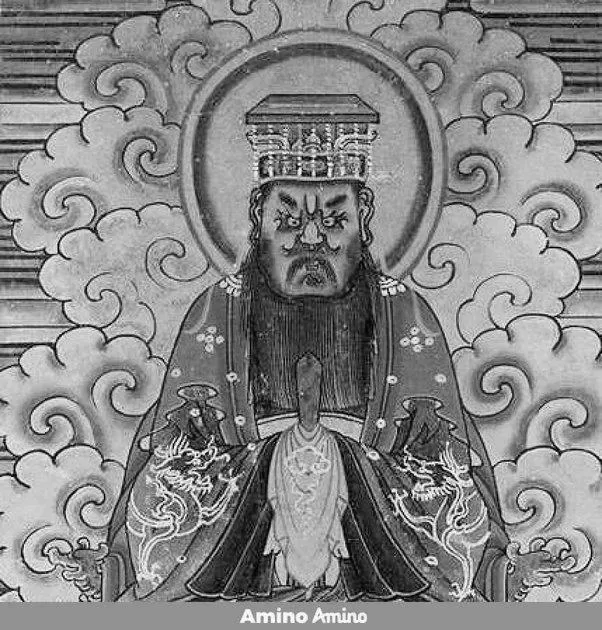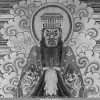Yan Wang
The Chinese deity of death, Yan Wang, is an important and enduring god in Chinese culture. He commands the gods of the underworld, records the lives of humans, and gives punishment according to the nature of those lives. The Chinese also worship another deity known as Long Wang, a god of the sea. Long Wang has a royal court of his own, and he commands all creatures that live in the sea. He is also said to bring rain to earth and to control the winds.
According to the Chinese belief system, a person’s soul is destined to go to Diyu after death. There, the soul will receive its punishment according to the severity of its crimes. A virtuous soul is sent to Heaven, while a sinful soul is relegated to wander aimlessly in Hell.
The beliefs about Yan eventually spread to other cultures such as Korea, Japan, and Vietnam. In Japan, the deity is known as King Enma or Great King Enma, and in Korea, he is known as Yeom-ra’. These deities were believed to be related to each other and were often worshiped together.
While many religions have a death god, the fact is that these deities have their own individuality and separate aspects. Some single religions even have gods of death of both sexes. In other traditions, married couples rule over the afterlife. It’s important to note that the death gods of different countries may have overlapping functions, but that’s only one of the aspects of Chinese mythology.
Chinese religion has over a thousand gods and goddesses. Some of these deities were created later than others, but all are important to the Chinese people. They continue to worship them today in many homes all over the world. They have been worshipped for thousands of years. It is believed that the ancient Chinese people were also influenced by many different cultures and religions. This is reflected in the pantheon of gods.
Throughout Chinese history, many different deities have been worshipped as the gods of death. The goddess of compassion, Guanyin, was originally named Tara and derived from the tears of a bodhisattva named Avalokitesvara. She was seen as the female counterpart of Avalokitesvara. The deity was introduced to China through the Silk Road trade during the Han Dynasty. It is said that the goddess came to China in the form of a maiden named Miaoshan. Her father had wanted her to marry a wealthy priest, but instead she decided to weave her clothes instead of marrying him.
Diyu
According to Chinese belief, after death, the soul goes to the Chinese deity of death, Diyu. Depending on the crime committed, Diyu will punish or reward the soul. Virtuous souls will return to Earth as human beings, while sinful souls will wander aimlessly in Hell.
Diyu combines ideas from Buddhism, Taoism, and traditional Chinese folk religion. It serves as a punishment for sin, a rebirth after death, and a way to punish evil spirits. There are many different deities associated with Diyu, though, which have conflicting purposes and names.
Diyu is also known as Yan. In addition to his role as the ruler of the underworld, Yan also presides over the death of a deceased person. His minions include a judge who holds a book with every soul’s birth and death date. The guardians of hell bring newly dead people before him to be judged. Good deeds earn good future lives, while misdeeds result in a miserable, torturous death.
In Chinese mythology, King Yama is the lord of death and king of hell, and a judge for the dead. King Yama is a feared god in several belief systems, including Chinese folk religion, Buddhism, Taoism, Sikhismi religion, and Zoroastrianism.
According to Chinese belief, everyone will go to Diyu after death, and the length of time they will spend there will depend on their particular sins. After punishment, the soul will return to earth to live again in a new physical body. At this point, God Yama will decide when the soul will go to the next stage of life.
Chinese popular religion teaches that there are three realms in the universe. The first is the Heavenly Domain, the second is Earth, and the third is the Underworld Domain. The deceased souls must take responsibility for their actions in life and submit to their punishments in the Underworld.
Chinese folklore describes Diyu as a goddess of death, and she is a representative of death. The Chinese deity is represented as a white woman in a red dress, a representation of the emperor, and a female deity. In some stories, she is represented by a dragon. In addition to the human form of Diyu, there are three different gods. The first king, known as Yanluo Wang, is the Chinese version of Yama. Nevertheless, he was demoted to the fifth court for being too lenient. The second king, Yuan Xue, has jurisdiction over a region that punishes dishonest go-betweens, fraudulent trustees, and slanderers. The third king, meanwhile, punishes people who are miserly rich and
Taiyi Jiuku Tianzun
The Chinese deity of death Taiyi Jiu Ku Tianzun is often called the Heavenly Venerable Who Saves Distress. His image is encased in an auspicious frame and is regarded as a permit for the soul to leave the netherworld. In his writings, Lagerway has called him a “dark path road-puller.” Dunkelweg is the German word for darkness.
The name of the deity is also derived from the two characters for “permanence”: yin and yang. Taiyi Jiuku Tianzun is a composite of the two. According to traditional Chinese mythology, the White Impermanence is tall and thin, and the Black Impermanence is orc-like and enshrouded in chains. In Southeast Asia, the deity is known as Dalaoye or Erlaoye, while in China, he is referred to as the First Master.
The Taiyi Jiuku Tianzun is the most important deity in Chinese religion, as he saves the souls of sentient beings. He can take on any form and can even lead the soul to paradise. However, his role as a savior is not a central one, as other Chinese deities are primarily associated with the afterlife. As such, many people worship him during funeral rites and during the Hungry Ghost Festival.
Besides the Chinese name, Taiyi Jiuku Tianzun has several other names in the country, including Yuanshi tianzun, Xia Dong Yuan, Ri Ji Shi Liang, and Daozei qinling. These are just a few of the more common ones.
In addition to its mystical properties, the Chinese deity of death Taiyi Jiuku Tianzun is also revered in Chinese medicine. His talismans are used to cleanse the body and prepare new clothing for the afterlife. They also serve as summoning tools of the gods and spirits. Many talismans carry talismanic names derived from the “Great Law of the Great Clarity Numinous Treasure.”
Lu Ban
In Chinese mythology, the Chinese deity of death Lu Ban is the patron of craftsmen, builders, and engineers. He is attributed with many inventions, including a lifting device for burials. In addition, Lu Ban is credited with creating the world’s first pedal-powered cycle. While this machine bears little resemblance to the bicycle we know today, prototypes show it was functional. Lu Ban was revered for his innovations and was considered a great craftsman in his own time.
Chinese mythology is filled with numerous prominent figures. While there is a lot of discussion about Lu Ban, we should take a closer look at the person behind this figure. There is no single, authoritative interpretation of his life, but there are some common traits. In addition to being the patron of death, Lu Ban also helps the vulnerable and the disadvantaged.
Lu Ban is believed to have been born in Shanxi into an elite family. He then travelled to Lushan Mountain in Jiangxi, where he encountered a fire dragon named Han Zhongli and taught him to harness his magical powers. Upon learning his new abilities, he performed ten arduous tasks to prove his skills. He then traveled for four hundred years, performing various tasks.
As a Taoist, Lu Ban is highly revered in Chinese mythology. His legends are common throughout the country. It is believed that he wrote a legendary scripture, but it is not available for public consumption. However, as with other Taoist figures, the legends about Lu Ban are often difficult to trace.
Lu Ban was also revered as the patron of builders and craftsmen. Many master engineers and construction workers invoke him, and he is believed to be the patron of these professions. The life of Lu Ban is dated to the Spring and Autumn Period of the Zhou dynasty, when Chinese culture underwent great changes. During this time, the teachings of Confucius were widely spread, and an emphasis on learning and studying became part of Chinese society.
The story of Lan ban’s birth is an interesting one. According to legend, she was buried under fallen rocks and later, people would build temples to worship her. This way, they could honor her as the Buddha Mother.







